The field of dental implantology can provide the dental forensics division an invaluable tool in the identification process of the unknown and missing. The great potential of this unique forensic dentistry division has been grossly overlooked and can truly enhance identification options.
The identification of persons through dental records, at least in the United States, can be traced back to 1776 with the identification of Dr. Joseph Warren, an American Revolutionary general killed in the Battle of Bunker Hill. Warren had been buried by British troops with another soldier and was exhumed 10 months later for proper burial.
The dentist who made the positive dental identification was American Revolutionary icon Paul Revere. Revere was not only a silversmith by trade, but also a well-known dentist at that time. Revere identified General Warren by a wire and ivory bridge Revere had constructed for the general to replace a missing canine tooth.
| Figure 1: Subperiosteal design dental implants | ||
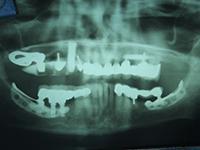 |
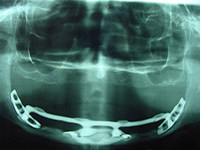 |
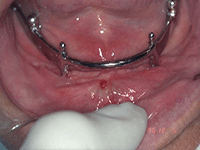 |
Commercial dental implants came to the United States in 1940 with Gustavo Dahl presenting the first dental implants—a subperiosteal design (Figure 1). Dental implants have undergone various transformations in design, shape architecture, and metallurgy or component constituency. Currently, hundreds of different designs and components exist. Since their inception in 1940, implants have changed from the subperiosteal design to blade-type or endosteal implants invented by Dr. Leonard Linkow of New York (Figure 2), to modern screw-type implants (Figure 3) and mini implants (Figure 4), with each type promoting different restorative options in the field of dental implantology. All of these, when located in unknown remains, can provide a useful tool for the forensic dentist as a possible piece of the puzzle in the identification protocol.
| Figure 2: Blade-type or endosteal dental implants |
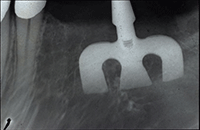 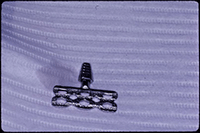 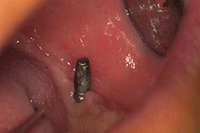 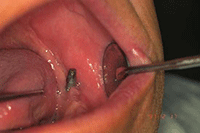 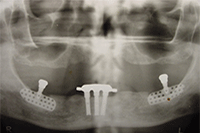 |
| Figure 3: Screw-type dental implants |
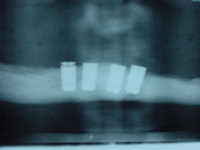 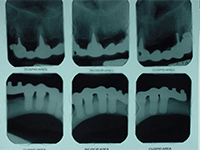 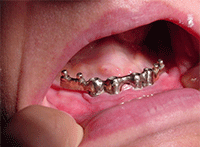 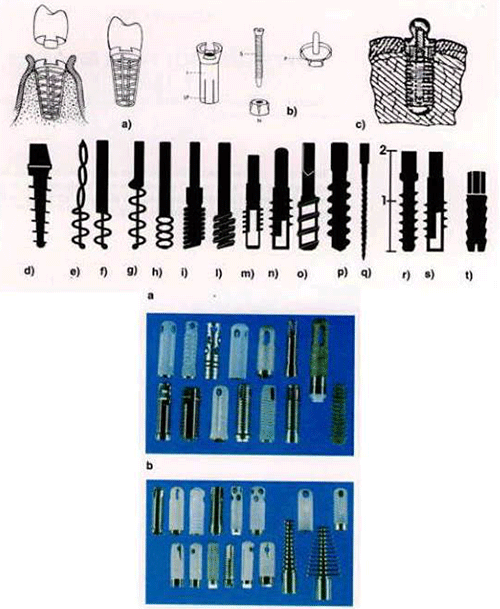 |
| Figure 4: Mini dental implants |
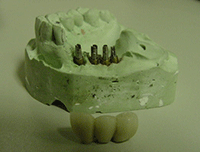 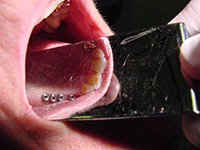 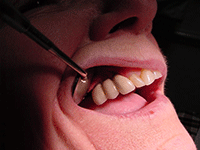 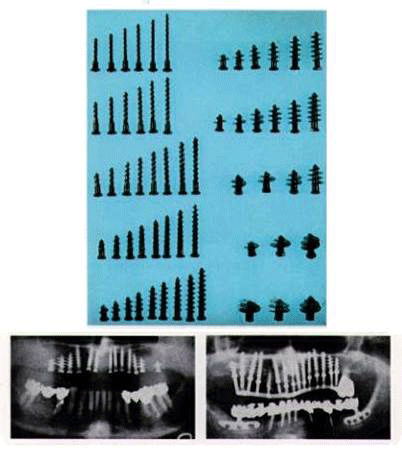 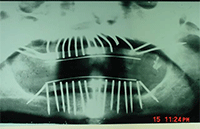 |
Between August 2013 and August 2014, approximately $600 million was spent on dental implants in the United States alone. With dental restoration becoming a reality, when in the past only dentures were an alternative, there now exists a tremendous opportunity to enhance identification of human remains and bring closure to families in search of their loved ones. However, action must be taken now. Requiring manufacturers to encode or number prosthetic devices was brought to U.S. congressional attention six years ago, and thus far, no action has taken place. With today’s technology, the cost of implementing such a requirement is insignificant, costing less than 50 cents per implant or crown. This encoding process could easily be applied to all prosthetic orthopedic implants inserted in a human body (e.g., hips, knees, shoulders).
A recent case of dental identification took place when a mandible (lower jaw) was found on a beach in California. After X-rays were taken, it was apparent that the mandible had a dental implant, which was referred for identification of the type and manufacturer of the implant. With the cooperation of several people in the industry, a forensic dentist was able to identify the manufacturer, type, and approximate year it was produced. The mandible’s identification used the current methodology in which a potential 185,000 practicing dentists who make prosthetic dental devices can be reduced to approximately 400 based on the manufacturer of various types of dental prosthetic devices. With mandatory etching of serial numbers, this process could be accomplished in minutes and reduced to one prosthetic product. This is particularly important as a method of identification with the abundance of dental implants that are being placed throughout the United States, and it is imperative that law enforcement and investigators take the opportunity to utilize dental implants or all orthopedic appliances in the identification of unknown remains in the United States.
A database could be established through the Federal Bureau of Investigation (FBI) or other U.S. or international agency with protocols developed for record retention and data entry with the help of the dental profession. The identification numbers are not visible to the naked eye and can be read only with a special reader device magnifier, which would be possessed by medical examiners and implant manufacturers.
The implementation of standard markings for implants will provide greater opportunities for the identification of human remains and missing persons, assisting both investigators and those who seek answers about a missing family member. The IACP and the American Society of Forensic Odontology have made resolutions regarding this matter, with both organizations stating support for the concept.1♦
Note:
1IACP Forensics Committee, “Dental Implants and Prosthetics,” IACP Resolution adopted at the 112th Annual Conference of the International Association of Chiefs of Police (Miami, FL, September 27, 2005), 24, http://www.theiacp.org/Portals/0/pdfs/WhatsNew/ACF6B4.pdf (accessed September 17, 2014).
|
Dr. Charles S. Mandell is a member of the IACP Forensic Committee, a Forensic Odontologist, and an active member of American Academy of Forensic Sciences (AAFS). William Berger is a past president of the IACP (2001–2002) and served as police chief of Palm Bay, Florida, until 2011. He is a U.S. Marshal for the Middle District of Florida. |
Please cite as:
Charles S. Mandell and William Berger, “Dental Implantology: An Emerging Technology in the Identification of Missing Persons,” The Police Chief 81 (October 2014): online only article.



